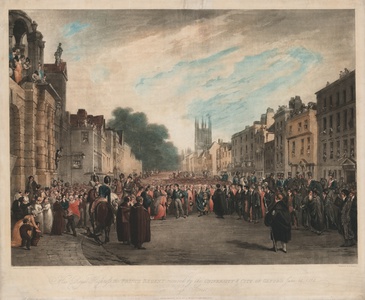| Method | Mezzotint printed in colour |
| Artist | Charles Turner after George Jones Esqr. |
| Published | Oxford, Published Octr. 21. 1815, by Mr. Jones, Printseller, High Street. |
| Dimensions | Image 470 x 670 mm, Plate 600 x 725 mm, Sheet 605 x 738 mm |
| Notes |
A rare, large-scale and separately published, print looking down Oxford High Street towards Magdalen Tower with the entrance to Queens College on the left. The street and surrounding windows and rooftops are filled with a crowd of Town and Gown as they clamour for a view of the Prince Regent being welcomed by dignitaries of the City and University in full regalia. The Prince Regent, accompanied by the Emperor of Russia and the King of Prussia, made a three-day visit to Oxford in June, 1814. The Prince stayed with the Dean of Christ Church, the Emperor with the Warden of Merton, and the King with the President of Corpus Christi. 'The whole procession of the University and City, the University on the right hand and the City on the left, advanced uncovered up the High Street' for the reception here depicted. It was followed by a banquet in the Radcliffe Library, illuminations, and on the following day, the giving of Diplomas to the visitors in the Sheldonian Theatre, accompanied by lengthy recitations of odes in Latin and Greek. The print is accompanied by a copy of "An Account of the Visit of His Royal Highness The Prince Regent and their Imperial and Royal Majesties The Emperor of Russia and The King of Prussia to The University of Oxford in June MDCCCXIV". Oxford: Clarendon Press, 1815, 4° (269 x 212mm.)Two etched plates and one folding table. Bookplate of Henry Thomas Ellicombe. An exhaustive written account of the Prince Regent's visit to Oxford accompanied by the Allied Commanders, including descriptions of their reception, lavish banquets and full transcriptions of the speeches given. Charles Turner (1774-1857) was was an English mezzotint engraver and draughtsman. Hailing from Woodstock, Oxfordshire, Turner moved to London at the age of fifteen. He enrolled in The Royal Academy and, like many other engravers of the time, initially relied upon the patronage of wealthy and influential people. Turner had the considerable backing of the Marlborough family, for his grandmother had been a close companion of the Duchess. This relation led to important commissions. Turner would, for instance, engrave the Marlborough family portrait after the painting by Sir Joshua Reynolds. He was subsequently employed by the influential publisher John Boydell. Diversely gifted, Turner was as adept in the medium of mezzotint as he was in stipple and aquatint. This leant great scope to the subjects he could depict. Whether it was the engraving of Van Dyck or Rembrandt, or the topography of his namesake, Turner excelled. George Jones (1786 - 1869) was a British painter and draughstman. Son of the engraver, John Jones, George was noted for his militaristic, historical and biblical painting. He joined the Royal Montgomery Militia in 1812, and was part of the army of occupation in Paris after the Battle of Waterloo. Jones became a Royal Academician in 1824; and would later become the librarian and keeper of the institute. Whitman 769 Condition: Sheet lightly toned with colours slightly faded. Two repaired tears to top centre of sheet into image. Dirt buld-up and light creasing to margins, not affecting image. Paper watermarked "J. Whatman 1811". |
| Framing | unmounted |
| Price | £2,000.00 |
| Stock ID | 52219 |

